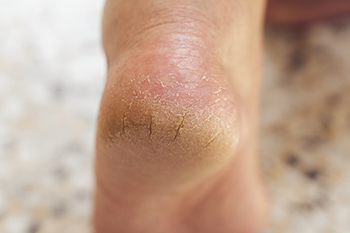
Dry cracked heels often result from a buildup of hard, dry skin that becomes less flexible and eventually splits under pressure. This condition, also known as heel fissures, can be caused by a range of factors including prolonged standing, obesity, aging, wearing open-heeled footwear, or exposure to cold weather. Certain health conditions such as diabetes, eczema, and thyroid issues can also contribute to dryness and skin thickening. Mild cases may be managed at home with regular exfoliation using a pumice stone and the use of thick moisturizers. Keeping feet moisturized and protected with well-fitting, closed-back shoes and soft socks can help retain hydration. Severe or painful cases may require treatment by a chiropodist to safely remove hardened skin and prescribe more effective topical treatments. If heel cracks persist or worsen, it is suggested that you see a chiropodist for diagnosis and appropriate treatment.
Cracked heels, also known as heel fissures, can cause pain and discomfort. If your cracked heels are bothering you, please consult with one of the chiropodists from Complete Family Footcare & Therapy. Our clinicians will assess your condition and provide you with quality foot and ankle treatment.
Dry, thickened skin around the rim of the heel is typically the first sign of cracked heels. While this condition is common and usually just a nuisance, some cases can be more severe. If left untreated and as more pressure is placed on the heel, the cracks become deeper and eventually walking and standing can be painful. These deep cracks or fissures can bleed and also become infected. Those with diabetes need to be especially careful as fissures could lead to diabetic foot ulcers.
Causes
Cracked heels can be the result of several different factors, including:
Dry skin
Taking long, hot showers or using harsh soaps
Standing for long periods of time
Walking barefoot
Walking in shoes with an open back, such as sandals or flip flops
Wearing shoes that do not fit properly
Living in a cold or dry climate
Certain skin conditions, such as eczema or psoriasis
Treatment
There are many at-home treatment remedies for cracked heels. Applying moisturizers to the heel can help hydrate the skin. Soaking your feet in warm water and exfoliating them with a loofah or pumice stone can help to buff away dead skin cells. If you are afflicted with cracked heels, it is recommended that you see a chiropodist for treatment.
Prevention
You can prevent cracked heels by:
Avoiding standing in one position for prolonged periods of time
Wearing well-fitted shoes with a closed back
Washing your feet with gentle soaps and lukewarm water
Moisturizing the feet daily
If you have any questions, please feel free to contact our offices located in . We offer the newest diagnostic and treatment technologies for all your foot care needs.
